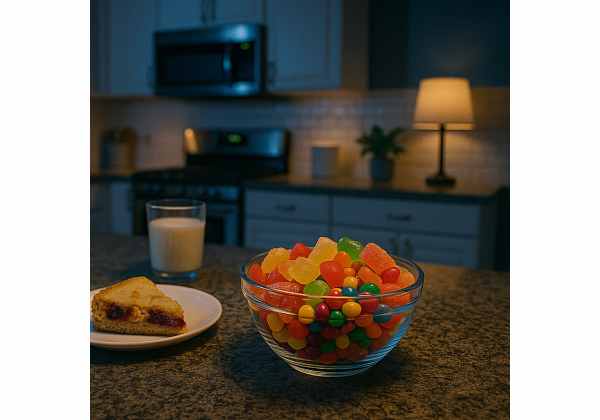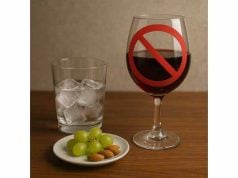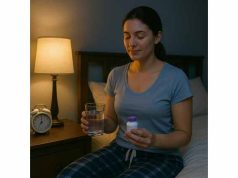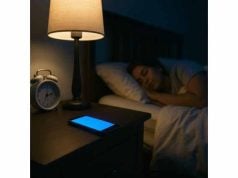
Night-time sugar cravings can feel like a switch flips after dinner: you eat well all day, then the urge for chocolate, cookies or cereal shows up right as you’re winding down. This guide explains why those cravings hit, how they affect weight loss, and what to do—tonight and long term. You’ll learn a practical step-by-step routine, smarter snack options, and how sleep, stress, and meal timing change your appetite signals. If evening sugar is your sticking point, you’ll leave with a plan you can use the very next night. For broader lifestyle levers that make these changes stick, see our concise guide to sleep, stress and habit basics for weight loss.
Table of Contents
- What night-time sugar cravings mean
- Why cravings spike at night
- Steps to stop cravings tonight
- Daytime fixes that prevent cravings
- Hunger or habit? Test it
- Mistakes to avoid at night
- Safety, meds and special cases
- Frequently asked questions
What night-time sugar cravings mean
A craving is not the same as hunger. Hunger is a whole-body signal (stomach emptiness, gentle pangs, steady desire for varied foods) that builds over time. A craving is more targeted and urgent: you want sweet and often a specific item, and the urge is tied to cues like a TV show, a couch, or an emotional state.
At night, cravings cluster for a few reasons that interact:
- Biology: Appetite hormones shift across the day. When you’re sleep-restricted or stressed, ghrelin (the “eat” signal) rises and leptin (the “enough” signal) falls. Evening also tends to be when decision fatigue is highest and willpower is lowest, so the same snack that was easy to skip at noon is compelling at 9 p.m.
- Circadian rhythm: Human preference for palatable, energy-dense foods often increases later in the day. Insulin sensitivity is lower in the evening, which can make sweet foods more tempting and more likely to spike and crash blood sugar.
- Learning and habit loops: If dessert “lives” after dinner, your brain learns that sugar follows dishes and TV. Over time, the trigger (finishing dinner) fires an automatic routine (grab something sweet), often independent of true hunger.
- Emotion and environment: Night is when stress processing, boredom, or loneliness surface. If the kitchen is open, visible sweets and easy access turn a feeling into a bite.
Why this matters for weight loss: Evening calories “count” the same as daytime calories, but they’re more likely to be unplanned—on top of your day’s intake. It’s not unusual for night-time sugar to add 200–600 extra calories, enough to erase a carefully managed deficit. If you’re also going to bed later after eating, digestion can blur with sleep, and restless sleep the next night pushes cravings higher again. That’s the “craving-sleep” loop many people feel stuck in.
First principle: You don’t have to “white-knuckle” cravings. Think of evening sugar as a solvable systems issue: adjust inputs (sleep, stress, meals), redesign cues (kitchen and routine), and add planned options that satisfy sweet taste without the blowback. If weight loss is your goal, pair these changes with a straightforward roadmap like our safe weight loss guide so your daily targets align with your evening plan.
Quick test you can try tonight: After dinner, set a 20-minute timer, sip water or tea, and do something hands-busy (tidy the kitchen, lay out clothes). When the timer ends, ask: Would I eat a balanced snack like Greek yogurt and berries? If yes, you’re likely hungry—eat a planned snack. If no, it’s a craving—use a non-food routine.
You’ll see exactly how to run that system below. For now, recognize that night-time sugar cravings are predictable, not mysterious—and predictable things can be engineered.
Why cravings spike at night
Sleep debt turns up the volume. Even one short night can raise next-day appetite signals and increase desire for high-sugar, high-fat foods. People often report a particular pull toward quick-energy options late in the evening—the exact time focus and self-control run lowest. Short sleep also lowers pain tolerance and mood, so sugar’s fast dopamine hit feels more rewarding.
Circadian timing matters. Your internal body clock shapes appetite, digestion, and glucose handling. In the evening, insulin sensitivity drops, and melatonin starts climbing as bedtime approaches. Eat a sugar-heavy snack in that window and you can see sharper glucose swings, which makes a second raid on the pantry more likely. It’s not “calories at night turn to fat”—it’s that your system handles them differently and cravings can cascade.
Stress and emotion layer on top. Cortisol (your stress hormone) nudges the body toward quick energy. Pair stress with habit (dessert follows Netflix) and you get a reliable loop. Boredom works similarly—sweet food provides novelty when the evening is otherwise flat.
Caffeine and alcohol timing push cravings. Late caffeine can delay melatonin and reduce sleep depth, both of which amplify next-day sweet cravings. Alcohol can make you sleepy at first, then fragment sleep and increase night wakings. Many people find that one or two drinks with dinner leads to a second snack around 10–11 p.m.
Light and screens play a role. Bright, blue-heavy light in the evening tells your clock “it’s still daytime,” which shifts hunger and delays sleepiness. If you pair scrolling with snacking, the cue becomes sticky: phone → sweets.
Hormonal life stages matter. In the late luteal phase (the days before a period), higher progesterone and fluid shifts can increase appetite and desire for sweet foods. During perimenopause, sleep becomes more fragile, and night wakings can trigger kitchen trips. The mechanism is personal, but the pattern—evening sweet cravings—shows up again and again.
Key insight: Most night-time sugar cravings are multi-cause. That’s why the fix is a small stack of moves, not a single “willpower” rule. If sleep, circadian cues, stress, and dinner composition all point the same way, cravings fall. For a deeper look at the sleep–appetite connection, see our guide to sleep and hunger hormones.
Steps to stop cravings tonight
You can make tonight easier without overhauling your entire diet. Here’s a seven-step plan that reduces the urge, clarifies real hunger, and gives you a satisfying fallback if you’re still hungry.
- Build a steady dinner.
Use a simple plate method: half vegetables (volume and fiber), a palm or two of protein (about 25–40 g), and a cupped handful of starch (rice, potatoes, pasta, or whole grains). Add a spoon of fats for flavor (olive oil, avocado, nuts). This combo slows digestion, steadies glucose, and pushes cravings later down or off the curve. - Finish with a planned “sweet finish,” small and structured.
If dessert is part of your evening, make it explicit, not open-ended: a single-serve Greek yogurt with berries, a square or two of dark chocolate with a glass of milk, or a baked apple with cinnamon. Keep the portion visible, then put the package away. Planned, bounded sweetness beats grazing. - Run the 20-minute rule.
After dinner, tidy the kitchen, start the dishwasher, and set the counter to “closed.” A timer buys space for appetite hormones to settle. Pair it with peppermint or chamomile tea and a tall glass of water (300–500 ml). Hydration plus bitter or minty flavors blunt sweet intensity. - Use an “if-then” choice.
If a craving hits after the timer, choose one of two paths:
- If you’d happily eat a balanced snack (e.g., cottage cheese with pineapple, apple with peanut butter, chia pudding), have it.
- If nothing sounds good but cookies, switch to a non-food routine (shower, walk, stretch, puzzle, phone-free reading) for 10 minutes. Most cravings crest and fall like a wave.
- Create a “green-light” snack box.
Stock 2–3 options that hit protein + fiber + sweet taste:
- 170 g plain Greek yogurt + ½ cup berries + cinnamon.
- Protein pudding (protein powder blended with milk), topped with a few chocolate chips.
- Chia yogurt: 2 tsp chia seeds stirred into yogurt; let sit 10 minutes.
- High-protein hot chocolate made with milk.
Set these at eye level and move trigger foods to low, opaque containers.
- Dim the lights and devices.
An hour before bed, dim lamps, switch screens to night mode, and cap social media. Light hygiene strengthens your “sleepiness” signal and reduces stimulus-driven snacking. - Close the loop with sleep.
Aim for a consistent lights-out and wake time. A stable sleep window (7–9 hours in bed) is one of the strongest craving reducers you can buy for free. If caffeine pulls your bedtime later, set a personal cut-off 8–10 hours before lights-out.
Optional quick add-ons tonight
- Post-dinner walk: 10 minutes lowers the desire to snack for many people by shifting state and smoothing glucose.
- Tooth brushing: A minty mouth is a natural “kitchen closed” signal.
- Portioning: Pre-portion sweets into small bowls or baggies—out of sight, out of hand.
For simple, ready-to-use options, bookmark our protein and fiber quick fixes so you always have a satisfying sweet alternative that supports your goal.
If you still eat more than planned: Log it neutrally, note the trigger (time, place, emotion), and adjust tomorrow’s inputs (protein at lunch, earlier dinner, screen limits). Progress is pattern-level, not perfect days.
Daytime fixes that prevent cravings
Night cravings often reflect daytime gaps. Shore up the day, and evenings get quiet.
1) Anchor protein early.
Start with 25–35 g of protein at breakfast (eggs, Greek yogurt, cottage cheese, tofu scramble, leftovers). Protein in the first meal dampens snackiness later and smooths the intensity of evening sugar pulls.
2) Keep meals predictable.
Long gaps lead to “arrive starving, leave stuffed,” which primes a late rebound. Most people do best with three meals and one planned snack, or four smaller meals spaced 3–4 hours apart. Set gentle anchors (e.g., lunch between 12–1:30, dinner 6–7:30).
3) Front-load fiber and volume.
Aim for 25–35 g fiber per day; get half by mid-afternoon. Add a big salad, cooked vegetables, beans, and whole grains. Fiber slows digestion and increases fullness signals that carry into the evening.
4) Hydrate on a schedule.
Dehydration masquerades as snackiness. A simple rule: a glass on waking, one mid-morning, one at lunch, one mid-afternoon, and one with dinner. Tea and sparkling water count.
5) Time your caffeine.
Enjoy coffee earlier and taper by early afternoon so it doesn’t nudge bedtime later. Later nights mean stronger sugar urges the next day.
6) Place carbs where they help.
Put the bulk of your starches with daylight meals and a modest serving with dinner. You’ll still sleep well, but you’ll avoid late glucose swings that leave you rummaging.
7) Move after meals.
Short, easy walks after lunch or dinner improve blood-sugar handling and lower the “I need something sweet” itch for many people. If you want a deeper framework, skim our guide to meal timing habits for appetite control.
8) Protect stress boundaries.
If work bleeds into the night, cravings fill the gap. Create an end-of-work ritual (brief walk, closing notebook, setting tomorrow’s top task) so dinner isn’t the start of a second shift.
Checklist you can print
- Protein: 25–35 g in first meal.
- Fiber: 15–20 g by 3 p.m.
- Fluids: 5 glasses by dinner.
- Caffeine cut-off: set and follow.
- Movement: 10 minutes post-lunch or dinner.
Small day changes compound into calm evenings.
Hunger or habit? Test it
Solving cravings starts with naming them. Use this quick triage whenever “something sweet” calls your name.
The three-question scan
- Body check: Do you feel stomach emptiness, gentle pangs, or low energy that food (not just sweets) would fix?
- Apple test: Would you eat a plain apple or a turkey sandwich? If yes, you’re hungry. If no, it’s likely a craving or emotion.
- Timing: When did you last eat a meal with protein and fiber? If it’s been 4+ hours, hunger is probable.
If it’s hunger, eat a structured snack
Pick one:
- 170 g Greek yogurt + fruit.
- 2 boiled eggs + small piece of fruit.
- Cottage cheese + pineapple.
- Whole-grain toast + peanut butter.
Add a glass of water, then re-evaluate.
If it’s habit or emotion, change the state
Cravings are state-dependent. Swap the trigger → routine → reward loop.
- Trigger: Finishing dishes, sitting on the couch.
- New routine (10 minutes): Shower, stretch routine, short walk, tidy a drawer, phone-free reading.
- Reward: Relief, progress, calm.
HALT check: Hungry, Angry, Lonely, Tired. If any non-hunger box is ticked, pick a non-food response that matches (call a friend, journal two lines, lie down for 15 minutes).
Urge surfing (60–90 seconds)
Close your eyes, breathe slowly, and label the craving like a passing wave (“rising… peaking… falling”). Most peaks pass in under two minutes.
Make the environment choose for you
- Keep sweets out of line of sight and in non-transparent containers.
- Place “green-light” snacks at eye level.
- Keep dessert dishes small; use actual plates, not packages.
If boredom is your evening trigger, our guide on how to stop boredom eating at night walks through more ways to swap routines without relying on food.
Note on flexibility: Absolute bans backfire. Plan satisfying, bounded sweet moments a few times per week so your brain doesn’t feel deprived.
Mistakes to avoid at night
Skipping dinner or going too light.
A tiny salad and a sigh will not hold you through the evening. You’ll end up in the pantry at 10 p.m. Build a balanced plate with enough protein and starch to keep you steady.
“Saving calories” for dessert.
Arriving at the couch hungry turns dessert into a free-for-all. Eat a real dinner, then have a planned sweet finish if you want one.
Trigger foods within reach.
Open bags and family-size packages invite mindless handfuls. Pre-portion into small bowls and put the rest away before you sit down.
Ultra-processed “diet desserts.”
Zero-calorie sweets can amplify sweet drive in some people and keep the taste loop alive. They’re not forbidden, but if you notice “one leads to three,” replace them with protein-anchored sweet options.
Too much alcohol.
Even a couple of drinks can lower inhibitions, nudge you toward sugary mixes, and fragment sleep—fuel for next-day cravings. Try alcohol-free weekdays or a hard stop after one drink with dinner.
Late caffeine.
Caffeine after mid-afternoon can push bedtime later. Later sleep → higher next-day sugar cravings.
All-or-nothing rules.
Rigid bans lead to rebellion. Better: boundaries (“I have a planned dessert after dinner on weekends,” “Weeknights I do tea and a yogurt bowl”).
Eating too early.
Dinner at 5 p.m. with a midnight bedtime often creates a long fuel gap. Add a small, structured snack at 8–9 p.m. if needed.
For more tactical ways to quiet the kitchen at night, review our concise list of late-night snacking strategies and pick two to try this week.
Safety, meds and special cases
Diabetes and reactive hypoglycemia.
If you use insulin or certain diabetes medications, night-time lows can present as urgent sugar cravings. Use your care plan, monitor as advised, and prefer balanced snacks (protein + modest carbs) to avoid rebound highs. If night lows are frequent, speak with your clinician about adjusting timing or doses.
Binge eating or loss of control.
If evening eating feels out of control, secretive, or distressing, you deserve more than tips. A registered dietitian and a therapist experienced in binge eating disorder can help you build a compassionate, effective plan.
ADHD, SSRIs, antipsychotics, and steroids.
Some medications alter appetite, sweet preference, or sleep architecture. If night cravings began or worsened after a medication change, ask your clinician about timing, alternatives, or supportive nutrition strategies.
Perimenopause and PMS.
Hormonal shifts can disrupt sleep and raise appetite. Focus on sleep protection (regular schedule, light hygiene, earlier caffeine cut-off), steady protein across meals, and pre-planned sweet finishes to keep the loop predictable.
Shift work.
Treat your work “night” as your biological day: eat balanced meals across your wake period, avoid heavy sugar near your sleep time, and use darkening, cool sleep environments. A small protein-plus-carb snack before sleep can prevent wake-ups to snack.
GI reflux and late sweets.
Sugary, high-fat desserts can worsen reflux, especially near bedtime. Leave a buffer of 2–3 hours between your last larger meal and lying down, and keep any late snack small and balanced.
When to get help now
- Repeated night wakings to eat.
- Dizziness, shaking, or sweating with evening cravings.
- Rapid weight changes, low mood, or anxiety tied to eating.
- Heavy snoring, pauses in breathing, or unrefreshing sleep (possible sleep apnea).
Safety is part of success. When the underlying issue is respected, the fixes above work better and faster.
Frequently asked questions
Why do I crave sugar at night?
Cravings rise at night because sleep debt, circadian timing, stress, and habit cues converge. Insulin sensitivity is lower, decision fatigue is higher, and learned routines (dessert after TV) fire automatically. Balanced dinners, light hygiene, and a planned sweet finish reduce the urge without rigid rules.
How can I stop night-time sugar cravings fast?
Run a simple sequence: close the kitchen, set a 20-minute timer, drink tea or water, and do a hands-busy task. If you’re still hungry, have a structured snack with protein and fiber, like Greek yogurt and berries. If not, switch to a short non-food routine until the wave passes.
What should I eat after dinner to lose weight?
Choose small, satisfying options anchored in protein: 170 g Greek yogurt with fruit, cottage cheese with pineapple, or a protein pudding. Keep portions visible and pre-planned. If dinner was balanced, these snacks end the meal cleanly and help you avoid unplanned grazing later.
Does eating fruit at night cause weight gain?
Fruit at night does not inherently cause weight gain. Calories and patterns matter most. A small fruit serving as part of a balanced snack can be helpful, especially paired with protein. Large portions of dried fruit or juice can escalate cravings; choose whole fruit instead.
Are artificial sweeteners okay at night?
They’re not off-limits, but responses vary. For some, very sweet zero-calorie desserts keep sugar cravings active. If you notice “one leads to three,” swap to options with protein and modest sweetness. If a small zero-sugar dessert helps you close the kitchen, keep it planned and bounded.
How long does it take to reduce sugar cravings?
Most people feel a difference in one to two weeks after improving sleep, standardizing meals, and using planned sweet finishes. The urge becomes less frequent and less intense. Expect normal ups and downs; focus on patterns, not perfect days.
References
- Late isocaloric eating increases hunger, decreases energy expenditure, and modifies metabolic pathways in adults with overweight and obesity 2022 (RCT)
- After Dinner Rest a While, After Supper Walk a Mile? A Systematic Review with Meta-analysis on the Acute Postprandial Glycemic Response to Exercise Before and After Meal Ingestion in Healthy Subjects and Patients with Impaired Glucose Tolerance 2023 (Systematic Review)
- Effect of short- and long-term protein consumption on appetite and appetite-regulating gastrointestinal hormones, a systematic review and meta-analysis of randomized controlled trials 2020 (Systematic Review)
- The effect of caffeine on subsequent sleep: A systematic review and meta-analysis 2023 (Systematic Review)
- Metabolic state switches between morning and evening in association with circadian clock in people without diabetes 2022 (Experimental Study)
Disclaimer
This article provides general information for educational purposes and is not a substitute for personalized medical advice, diagnosis, or treatment. Always consult your physician or a registered dietitian about your specific health needs, medications, and symptoms—especially if you have diabetes, disordered eating, or frequent night-time awakenings to eat.
If you found this helpful, consider sharing it with someone who struggles most after dinner, and follow us on Facebook, X, or whichever network you use to see future guides on sleep, stress, and habit-based weight loss.










